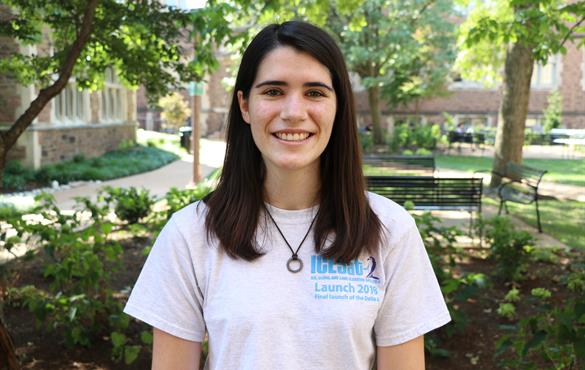Wiederhold helping NASA to build ICESat-2 locator app
Senior Emme Wiederhold is helping NASA develop an app so that anyone can determine the location of the ICE-Sat2 satellite in relation to the user
Emme Wiederhold, a senior majoring in computer science, has spent the past two summers working for NASA on different projects. She is now helping to develop an app so that anyone in the world can locate the Ice, Cloud and Land Elevation Satellite-2 (ICESat-2). We asked Emme about her experience as a two-time NASA intern.

Q. What have you worked on the past two summers?
A. During the summer of 2018, I worked at NASA's Goddard Space Flight Center in Maryland. I worked with the Ice, Cloud, and Land Elevation Satellite 2 (ICESat-2) team, a team of cryospheric scientists studying the change in sea and land ice on Earth using this satellite. On this team, I worked to build a module for an augmented reality mobile application called HoloGLOBE. The goal of this module is to inform the public about the ICESat-2 mission and get them excited about the data it's collecting. This summer, I interned at NASA's Jet Propulsion Laboratory in Southern California, working with the Microsoft HoloLens to build an augmented reality application for the Mars 2020 rover mission. The goal of this application is to allow scientists, geologists and other users to gain spatial awareness of the Martian environment to be able to better plan science goals for the rover. The Mars 2020 mission will be launching next year and will carry a sample caching system to gather samples from the Martian surface.
Q. What is the ICESat-2, and how did you get involved with it?
A. ICESat-2 is the Ice, Cloud, and Land Elevation Satellite 2. It is an Earth-observing satellite that uses a laser instrument called ATLAS, or the Advanced Topographic Laser Altimeter System, to measure the height of the Earth. This information can be used to monitor changes in land and sea ice thickness and elevation in our polar regions. I got involved with the ICESat-2 mission in the spring of 2018 when I received an opportunity to intern for the team during that summer. I was able to apply online to internships at various NASA centers, and this happened to be one in which I was particularly interested.
Q. What is the app you are developing, how will it work, and who can use it?
A. The mobile application that I'm currently developing for the ICESat-2 team is one that will allow the public to see when the satellite will next be passing overhead. Users will be able to enter any location in which they are interested and see a set of results for future dates and times when the satellite will be passing over that location. Anyone can use this app! It will be useful for all sorts of people, whether they are curious when the satellite is passing over so they can try to catch a glimpse of the green laser at night or the sun reflecting off the solar array during the day, or scientists wondering when they can expect to access data from the satellite for their region.
Q. What is your role in the app development?
A. My role in the development of the application has been fully involved. The project started off with needing to host the ground track data on a server. Now that the back-end, server-based step is mostly complete, the project has been transitioning into more of a front-end development effort. This involves using Xcode to code in Swift and deploy prototypes of the project to mobile devices for testing. The app itself uses that server to perform queries depending on the locations that the user inputs.
Q. What has it been like to work on these projects with NASA as an undergraduate student?
A. I've had such a fantastic experience working with NASA as an undergraduate student, and I'm so grateful for all of the opportunities that I continue to receive from the teams I've worked with. Being able to "nerd out" about space and be amongst so many individuals who are passionate about space, science and technology has certainly been an incredible experience for me. And by means of working on these projects, I've discovered so many more things about which I'm passionate and feel as though I've found a niche type of computer science and programming that I really enjoy.



